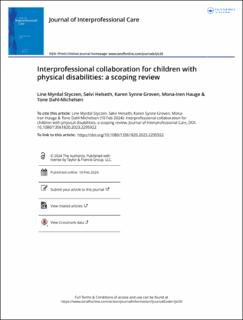| dc.contributor.author | Styczen, Line Myrdal | |
| dc.contributor.author | Helseth, Sølvi | |
| dc.contributor.author | Groven, Karen Synne | |
| dc.contributor.author | Hauge, Mona-Iren | |
| dc.contributor.author | Dahl-Michelsen, Tone | |
| dc.date.accessioned | 2024-02-13T09:26:35Z | |
| dc.date.available | 2024-02-13T09:26:35Z | |
| dc.date.created | 2024-02-12T14:47:08Z | |
| dc.date.issued | 2024 | |
| dc.identifier.citation | Journal of Interprofessional Care. | en_US |
| dc.identifier.issn | 1356-1820 | |
| dc.identifier.uri | https://hdl.handle.net/11250/3117175 | |
| dc.description | This is an Open Access article distributed under the terms of the Creative Commons Attribution License (http://creativecommons.org/licenses/by/4.0/), which permits unrestricted use, distribution, and reproduction in any medium, provided the original work is properly cited. The terms on which this article has been published allow the posting of the Accepted Manuscript in a repository by the author(s) or with their consent. | en_US |
| dc.description.abstract | Interprofessional collaboration is vital in the context of service delivery for children with physical disabilities. Despite the established importance of interprofessional collaboration and an increasing focus on research on this topic, there is no overview of the research. A scoping review was conducted to explore current knowledge on interprofessional collaboration for children with physical disabilities from the point of view of the actors involved. The steps of this review included identifying a research question, developing a protocol, identifying relevant research, selecting studies, summarizing and analyzing the data, and reporting and discussing the results. Through databases and studies from hand- searches, 4,688 records were screened. A total of 29 studies were included. We found that four themes: communication, knowledge, roles, and culture in interprofessional collaboration illustrate current knowl-edge on the topic. Interprofessional collaboration for children with physical disabilities is shown to be composed of these four themes, depending on the actors involved. Interprofessional collaboration is affected by how these four themes appear; they mainly act as barriers and, to a lesser extent, as facilitators for interprofessional collaboration. Whether and how the themes appear as facilitators need further exploration to support innovation of interprofessional collaboration. | en_US |
| dc.language.iso | eng | en_US |
| dc.publisher | Taylor & Francis | en_US |
| dc.rights | Navngivelse 4.0 Internasjonal | * |
| dc.rights.uri | http://creativecommons.org/licenses/by/4.0/deed.no | * |
| dc.subject | interprofessional practice | en_US |
| dc.subject | interprofessional collaboration | en_US |
| dc.subject | facilitators | en_US |
| dc.subject | barriers | en_US |
| dc.title | Interprofessional collaboration for children with physical disabilities: a scoping review | en_US |
| dc.type | Peer reviewed | en_US |
| dc.type | Journal article | en_US |
| dc.description.version | publishedVersion | en_US |
| dc.rights.holder | © 2024 The Author(s). Published with license by Taylor & Francis Group, LLC. | en_US |
| dc.source.pagenumber | 1-17 | en_US |
| dc.source.journal | Journal of Interprofessional Care. 2024 | en_US |
| dc.identifier.doi | https://doi.org/10.1080/13561820.2023.2295922 | |
| dc.identifier.cristin | 2245197 | |
| cristin.ispublished | true | |
| cristin.fulltext | original | |
| cristin.qualitycode | 1 | |

